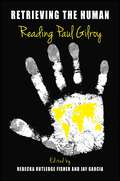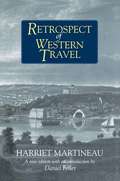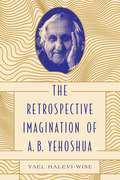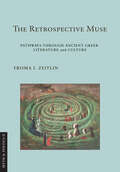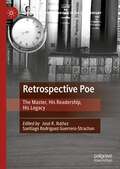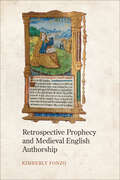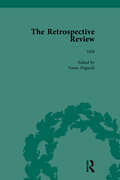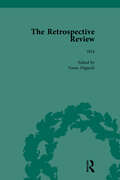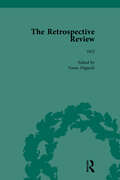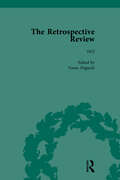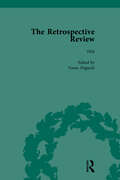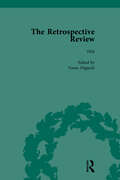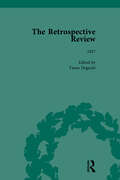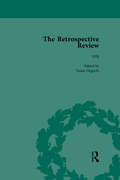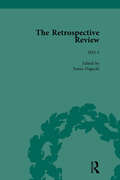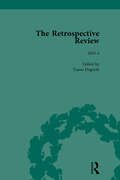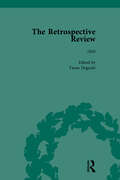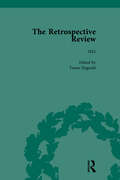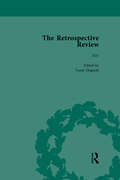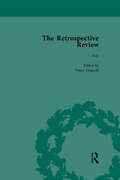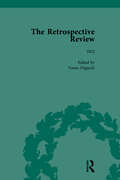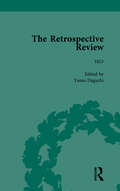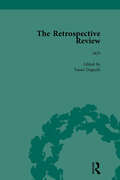- Table View
- List View
Retrieving the Human: Reading Paul Gilroy (SUNY series, Philosophy and Race)
by Rebecka Rutledge Fisher; Jay GarciaIn the more than twenty years since the publication of his book The Black Atlantic, Paul Gilroy has become a leading Afro-European intellectual whose work in the cultural studies of race has influenced a number of fields and made the study of black Atlantic literatures and cultures an enduring part of the humanities. The essays in this collection examine the full trajectory of Gilroy's work, looking beyond The Black Atlantic to consider also his work in the intervening years, focusing in particular on his investigations of contemporary black life in the United States, histories of human rights, and the politics of memory and empire in contemporary Britain. With an essay by Gilroy himself extending his longstanding examination of fascism, racial thinking, and European philosophical thought, in addition to an interview with Gilroy, this volume features Gilroy's own words alongside other scholars' alternative conceptualizations and critical rereadings of his works.
Retroland: A Reader's Guide to the Dazzling Diversity of Modern Fiction
by Peter KempThe essential companion for lovers of the contemporary novel Over the past fifty years, fiction in English has never looked more various. Books bulkier than Victorian three-deckers appear alongside works of minimalist brevity, and experiments with form have produced everything from verse novels to Twitter-thread narratives. This is truly a golden age. But what unites this kaleidoscopic array of genres and styles? Celebrated writer and critic Peter Kemp shows how modern writers are obsessed with the past. In a series of engaging and illuminating chapters, Retroland traces this novelistic preoccupation with history, from the imperial and the political to the personal and the literary. Featuring famous names from across the United Kingdom, United States, and the wider Anglophone world, ranging from Salman Rushdie to Sarah Waters, Toni Morrison to Hilary Mantel, this is a work of remarkable synthesis and clarity—a wonderfully readable and enjoyably opinionated guide to our current literary landscape.
Retrospect of Western Travel: In Three Volumes, Volume 2 (Cambridge Library Collection - North American History Ser. #Volume 2)
by Harriet Martineau Daniel FellerThis abridged version of Harriet Martineau's narrative of her travels in Jacksonian America preserves her reporting on slavery and other current topics of the day, as well as her insights on women's place in society, and her observations and vignettes of famous people such as John Calhoun.
The Retrospective Imagination of A. B. Yehoshua (Dimyonot: Jews and the Cultural Imagination #9)
by Yael Halevi-WiseOnce referred to by the New York Times as the "Israeli Faulkner," A. B. Yehoshua’s fiction invites an assessment of Israel’s Jewish inheritance and the moral and political options that the country currently faces in the Middle East. The Retrospective Imagination of A. B. Yehoshua is an insightful overview of the fiction, nonfiction, and hundreds of critical responses to the work of Israel’s leading novelist.Instead of an exhaustive chronological-biographical account of Yehoshua’s artistic growth, Yael Halevi-Wise calls for a systematic appreciation of the author’s major themes and compositional patterns. Specifically, she argues for reading Yehoshua’s novels as reflections on the "condition of Israel," constructed multifocally to engage four intersecting levels of signification: psychological, sociological, historical, and historiosophic. Each of the book’s seven chapters employs a different interpretive method to showcase how Yehoshua’s constructions of character psychology, social relations, national history, and historiosophic allusions to traditional Jewish symbols manifest themselves across his novels. The book ends with a playful dialogue in the style of Yehoshua’s masterpiece, Mr. Mani, that interrogates his definition of Jewish identity.Masterfully written, with full control of all the relevant materials, Halevi-Wise’s assessment of Yehoshua will appeal to students and scholars of modern Jewish literature and Jewish studies.
The Retrospective Imagination of A. B. Yehoshua (Dimyonot)
by Yael Halevi-WiseOnce referred to by the New York Times as the “Israeli Faulkner,” A. B. Yehoshua’s fiction invites an assessment of Israel’s Jewish inheritance and the moral and political options that the country currently faces in the Middle East. The Retrospective Imagination of A. B. Yehoshua is an insightful overview of the fiction, nonfiction, and hundreds of critical responses to the work of Israel’s leading novelist.Instead of an exhaustive chronological-biographical account of Yehoshua’s artistic growth, Yael Halevi-Wise calls for a systematic appreciation of the author’s major themes and compositional patterns. Specifically, she argues for reading Yehoshua’s novels as reflections on the “condition of Israel,” constructed multifocally to engage four intersecting levels of signification: psychological, sociological, historical, and historiosophic. Each of the book’s seven chapters employs a different interpretive method to showcase how Yehoshua’s constructions of character psychology, social relations, national history, and historiosophic allusions to traditional Jewish symbols manifest themselves across his novels. The book ends with a playful dialogue in the style of Yehoshua’s masterpiece, Mr. Mani, that interrogates his definition of Jewish identity.Masterfully written, with full control of all the relevant materials, Halevi-Wise’s assessment of Yehoshua will appeal to students and scholars of modern Jewish literature and Jewish studies.
The Retrospective Muse: Pathways through Ancient Greek Literature and Culture (Myth and Poetics II)
by Froma I. ZeitlinThe Retrospective Muse showcases the celebrated work of Froma I. Zeitlin. Over many decades, Zeitlin's innovative studies have changed the field of classics. Her instantly recognizable work brings together anthropology, gender studies, cultural studies, and an acute literary sensibility to open ancient texts and ideas to new forms of understanding. A selection of her luminous essays on topics still timely today are collected for the first time in a volume that shows the full range and flair of her remarkable intellect. Together, these illuminating analyses show why Zeitlin's work on ancient Greek culture has had an enduring impact on scholars around the world, not just in classics but across multiple fields. From Homer to the Greek novel, from religion to erotics, from myth and ritual to theatrical performance, she expounds on some of the most important works of ancient writing and some of modernity's most significant critical questions. Zeitlin's writing still sheds light on the durable aspects of classics as a discipline, and this book encapsulates her achievement.
Retrospective Poe: The Master, His Readership, His Legacy (American Literature Readings in the 21st Century)
by José R. Ibáñez Santiago Rodríguez Guerrero-StrachanThis book analyzes a range of Edgar Allan Poe’s writing, focusing on new readings that engage with classical and (post)modern studies of his work and the troubling literary relationship that he had with T.S. Eliot. Whilst the book examines Poe’s influence in Spain, and how his figure has been marketed to young and adult Spanish reading audiences, it also explores the profound impact that Poe had on other audiences, such as in America, Greece, and Japan, from the nineteenth to the twenty-first century. The essays attest to Poe’s well-deserved reputation, his worldwide legacy, and his continued presence in global literature. This book will appeal particularly to university teachers, Poe scholars, graduate students, and general readers interested in Poe’s oeuvre.
Retrospective Prophecy and Medieval English Authorship
by Kimberly FonzoThe prescience of medieval English authors has long been a source of fascination to readers. Retrospective Prophecy and Medieval English Authorship draws attention to the ways that misinterpreted, proleptically added, or dubiously attributed prognostications influenced the reputations of famed Middle English authors. It illuminates the creative ways in which William Langland, John Gower, and Geoffrey Chaucer engaged with prophecy to cultivate their own identities and to speak to the problems of their age. Retrospective Prophecy and Medieval English Authorship examines the prophetic reputations of these well-known medieval authors whose fame made them especially subject to nationalist appropriation. Kimberly Fonzo explains that retrospectively co-opting the prophetic voices of canonical authors aids those looking to excuse or endorse key events of national history by implying that they were destined to happen. She challenges the reputations of Langland, Gower, and Chaucer as prophets of the Protestant Reformation, Richard II’s deposition, and secular Humanism, respectively. This intellectual and critical assessment of medieval authors and their works successfully makes the case that prophecy emerged and recurred as an important theme in medieval authorial self-representations.
The Retrospective Review Vol 1
by Yasuo DeguchiFounded in 1820 by Henry Southern, "The Retrospective Review" aimed to recall the public from an exclusive attention to new books, by making the merit of old ones the subject of critical discussion. This edition reproduces in facsimile all 18 volumes of the periodical published between 1820-1854.
The Retrospective Review Vol 10
by Yasuo DeguchiFounded in 1820 by Henry Southern, "The Retrospective Review" aimed to recall the public from an exclusive attention to new books, by making the merit of old ones the subject of critical discussion. This edition reproduces in facsimile all 18 volumes of the periodical published between 1820-1854.
The Retrospective Review Vol 11
by Yasuo DeguchiFounded in 1820 by Henry Southern, "The Retrospective Review" aimed to recall the public from an exclusive attention to new books, by making the merit of old ones the subject of critical discussion. This edition reproduces in facsimile all 18 volumes of the periodical published between 1820-1854.
The Retrospective Review Vol 12
by Yasuo DeguchiFounded in 1820 by Henry Southern, "The Retrospective Review" aimed to recall the public from an exclusive attention to new books, by making the merit of old ones the subject of critical discussion. This edition reproduces in facsimile all 18 volumes of the periodical published between 1820-1854.
The Retrospective Review Vol 13
by Yasuo DeguchiFounded in 1820 by Henry Southern, "The Retrospective Review" aimed to recall the public from an exclusive attention to new books, by making the merit of old ones the subject of critical discussion. This edition reproduces in facsimile all 18 volumes of the periodical published between 1820-1854.
The Retrospective Review Vol 14
by Yasuo DeguchiFounded in 1820 by Henry Southern, "The Retrospective Review" aimed to recall the public from an exclusive attention to new books, by making the merit of old ones the subject of critical discussion. This edition reproduces in facsimile all 18 volumes of the periodical published between 1820-1854.
The Retrospective Review Vol 15
by Yasuo DeguchiFounded in 1820 by Henry Southern, "The Retrospective Review" aimed to recall the public from an exclusive attention to new books, by making the merit of old ones the subject of critical discussion. This edition reproduces in facsimile all 18 volumes of the periodical published between 1820-1854.
The Retrospective Review Vol 16
by Yasuo DeguchiFounded in 1820 by Henry Southern, "The Retrospective Review" aimed to recall the public from an exclusive attention to new books, by making the merit of old ones the subject of critical discussion. This edition reproduces in facsimile all 18 volumes of the periodical published between 1820-1854.
The Retrospective Review Vol 17
by Yasuo DeguchiFounded in 1820 by Henry Southern, "The Retrospective Review" aimed to recall the public from an exclusive attention to new books, by making the merit of old ones the subject of critical discussion. This edition reproduces in facsimile all 18 volumes of the periodical published between 1820-1854.
The Retrospective Review Vol 18
by Yasuo DeguchiFounded in 1820 by Henry Southern, "The Retrospective Review" aimed to recall the public from an exclusive attention to new books, by making the merit of old ones the subject of critical discussion. This edition reproduces in facsimile all 18 volumes of the periodical published between 1820-1854.
The Retrospective Review Vol 2
by Yasuo DeguchiFounded in 1820 by Henry Southern, "The Retrospective Review" aimed to recall the public from an exclusive attention to new books, by making the merit of old ones the subject of critical discussion. This edition reproduces in facsimile all 18 volumes of the periodical published between 1820-1854.
The Retrospective Review Vol 3
by Yasuo DeguchiFounded in 1820 by Henry Southern, "The Retrospective Review" aimed to recall the public from an exclusive attention to new books, by making the merit of old ones the subject of critical discussion. This edition reproduces in facsimile all 18 volumes of the periodical published between 1820-1854.
The Retrospective Review Vol 4
by Yasuo DeguchiFounded in 1820 by Henry Southern, "The Retrospective Review" aimed to recall the public from an exclusive attention to new books, by making the merit of old ones the subject of critical discussion. This edition reproduces in facsimile all 18 volumes of the periodical published between 1820-1854.
The Retrospective Review Vol 5
by Yasuo DeguchiFounded in 1820 by Henry Southern, "The Retrospective Review" aimed to recall the public from an exclusive attention to new books, by making the merit of old ones the subject of critical discussion. This edition reproduces in facsimile all 18 volumes of the periodical published between 1820-1854.
The Retrospective Review Vol 6
by Yasuo DeguchiFounded in 1820 by Henry Southern, "The Retrospective Review" aimed to recall the public from an exclusive attention to new books, by making the merit of old ones the subject of critical discussion. This edition reproduces in facsimile all 18 volumes of the periodical published between 1820-1854.
The Retrospective Review Vol 7
by Yasuo DeguchiFounded in 1820 by Henry Southern, "The Retrospective Review" aimed to recall the public from an exclusive attention to new books, by making the merit of old ones the subject of critical discussion. This edition reproduces in facsimile all 18 volumes of the periodical published between 1820-1854.
The Retrospective Review Vol 8
by Yasuo DeguchiFounded in 1820 by Henry Southern, "The Retrospective Review" aimed to recall the public from an exclusive attention to new books, by making the merit of old ones the subject of critical discussion. This edition reproduces in facsimile all 18 volumes of the periodical published between 1820-1854.
